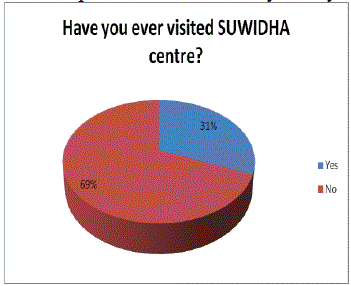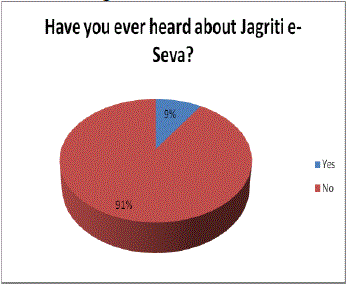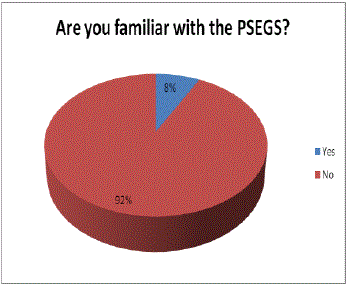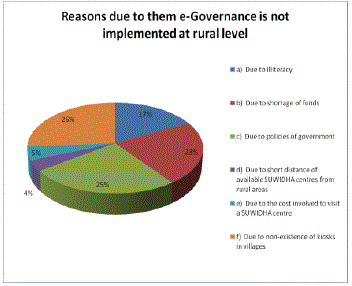Keywords
|
| DIT (Department of Information Technology), e-Governance, RTI (Right To Information), SUWIDHA, PSEGS (Punjab State e-Governance Society). |
INTRODUCTION
|
| A number of projects are implemented under e-Governance in Punjab to provide services to the citizens. These projects are implemented mainly at district, tehsil and sub-tehsil level which are far away from the access of rural citizens. To get services, a lot of time and money is wasted by these citizens. Even, most of the time these people are misguided by the agents as they do not know how to get the services and the actual charges of services. Also, rural citizens are not aware about running projects, that is why, they are not able to access the services. This research paper is focused on the factors for the implementation of e-Governance in rural areas of Punjab. These factors mainly include lack of awareness in citizens. It also highlights the e-Governance initiatives taken in the state of Punjab and the participation of urban as well as rural people to access the services provided through these initiatives. The research paper also describes the obstacles faced by rural citizens to get an access of e-Governance services and thus the need of implementation of e-Governance in rural areas of Punjab. |
OBJECTIVES AND SCOPE OF STUDY
|
| A number of difficulties are being faced by the e-Government of Punjab for the implementation of e-Governance. The main objectives of this study are: |
| • To find the difficulties in implementation of e-governance in rural areas of Punjab. |
| • To aware the concerned authorities about these difficulties so that suitable actions can be taken to overcome these difficulties. |
| • To create awareness among the rural people of Punjab about e-Governance so that they may take advantage of these services for their welfare. |
| • To increase the participation of rural people along with the urban people in e-Governance projects so that these projects can be implemented successfully. |
RESEARCH METHODOLOGY
|
| In order to attain the objectives of the study, the following research methodology is adopted: |
| The study is based on primary and secondary data and is of empirical nature. For data collection, following methods are used: |
| (i) RTI (Right to Information) act is the main source to collect data from various government authorities such as SUWIDHA centers which are responsible for providing e-Governance services. |
| (ii) Surveys are conducted to collect the response of individuals who are using e-Governance services to know whether they are satisfied with these services or not. For surveys, a questionnaire is used to collect the response from target respondents. The questionnaire is prepared in both English and Punjabi version. |
DATA ANALYSIS AND INTERPRETATION (USING PIE CHARTS)
|
| According to the e-Readiness Reports of DIT (Department of Information Technology) of India, Andhra Pradesh, Punjab, Delhi, Chandigarh and Tamil Nadu are stated as the leaders in the use of ICTs. DOIT (Department Of Information Technology) in Punjab and the state government has taken a number of initiatives to implement e-Governance. These initiatives include SUWIDHA, Saanjh Kendras, Fard Kendras, PSEGS (Punjab State e-Governance Society), Sukhmani Societies, e-District etc.. Recently, Punjab Government has claimed its achievements in implementing e-Governance by implementing 150 Fard Kendras, 110 SUWIDHA centres, 500 Saanjh Kendras and e-Panchayat for internal computerization of Panchayats. |
| The projects about which Punjab Government has claimed are implemented either at District, Tehsil or Sub-Tehsil level. If we talk about the distribution of population in Punjab, then only 34% population resides in urban areas and 66% of population resides in rural areas which are far away from Districts or Tehsils. Punjab Government is claiming its achievements to implement e-Governance projects successfully but how it is possible for these projects to be successful if these are not in the access of 66% of the population. |
| Besides all this, the results of the survey show that 78% of the people have never heard about e-Governance. Although SUWIDHA centres are implemented up-to Sub-tehsil level, yet only 31% of the people have ever visited |
| These centres for some purpose. Not only this, some projects like Jagriti e-Seva, PSEGS (Punjab State e-Governance Society), Sukhmani Societies etc. are unknown to the majority of the citizens. |
| According to the results of survey, the following are main reasons due to them e-Governance is not implemented at rural level: |
| • Illiteracy (17%) |
| • Shortage of funds (23%) |
| • Policies of government (25%) |
| • Non-existence of kiosks in villages (26%) |
| • Short distance of available SUWIDHA centres from rural areas (4%) |
| • Cost involved to visit a SUWIDHA centre (5%) |
| The survey reveals public opinion that what role our state government should play to effectively implement e-Governance in rural areas: |
| • Majority of the citizens said that there should be a SUWIDHA centre in each city and village as government can afford its cost. |
| • Majority of the citizens has also suggested that government should held camps to create awareness of e-Governance among rural people. |
| According to the Election Manifesto 2012-17 of SAD-BJP Alliance (Current ruling party) in Punjab has promised to make the whole state with Wi-Fi connectivity but no such step has taken in this favour. |
| According to the information collected through RTIs, most of the SUWIDHA centres at sub-tehsil level has only 1 or 2 staff members. A large number of villages fall under sub-tehsils to take services from these centres. Majority of these centres only have 1 staff member. In case of absence of that member no one is there to attend the visitors. Also, the amount of salary paid to these employees varies from Rs. 6200 to Rs. 7350 only which is a very less amount as compared to the working hours of the SUWIDHA centres (9 a.m. to 5 p.m.). On one hand, Punjab Government is promising to make Punjab an e-Government state while on the other hand it cannot even motivate its employees to work hard by providing them impressive salaries. Even, the labourers earn more than the employees of SUWIDHA centres. Hence, how we can expect from these employees to work with dedication. The information collected through RTIs also reveals that no internet connection is available at SUWIDHA centres of sub-tehsil level. If for any query, internet is required, then how that query can be interpreted. |
| We know that the small towns and even the cities are suffering from the power cuts. But the battery back-up at these centres is maximum of half an hour. If the power cut is longer than this period of time, then how it is possible to serve the people without any interruption. All these are the major problems which leads to the poor implementation of e-Governance in the state and also these problems cannot be avoided. Our State Government’s claim to make Punjab an e-Government State can only said to be true of these problems will be removed. |
CONCLUSION
|
| Due to the insincere efforts of Punjab Government , e-Governance projects are not 100% successful in their implementation. Although a number of projects are running all over the state, yet the government is not able to serve the citizens with e-Governance services. The participation of citizens in accessing these services is very less as they are not aware about most of the services provided by these projects. Even, some of the projects are unknown to them. Therefore, the frequency of the centres under these projects should be increased at rural level so that rural areas can take benefits from these projects. Also, Government must held awareness camps in rural as well as urban areas to create the awareness among people so that their participation in accessing these services can be increased for the 100% success of implementation of e-Governance. Our state government should also tie-up with NGOs which may take sincere actions in creating awareness among citizens. |
Figures at a glance
|
 |
 |
 |
 |
| Figure 1 |
Figure 2 |
Figure 3 |
Figure 4 |
|
References
|
- Sushil Kumar Singla, HimanshuAggarwal, “Impact and Scope of e-Governance Initiatives in State of Punjab (INDIA)”, International Journal of Computer Applications, Vol.44 –No.14, April 2012.
- Vandana Gupta, Ajay Sharma, “E-Governance in India: Problems, Challenges and Prospects”, The International Journal’s Research Journal of Economics and Business Studies, Vol. 01, Number: 09, July-2012.
- Dr. Vikram Singh, SubhashChander, Amit Kumar, “E-Governance in Development of Rural Economy”, International Journal of Computer Science and Technology, Vol. 2 Issue, Issue 4, Oct.-Dec.2011.
- Chandan Singh, “E-Governance Challenges and Success Factors of Projects- An Indian Experience”, International Journal of Multidisciplinary Research, Vol.1 Issue 7, Nov. 2011.
- Dr. Sanjay Kumar Dwivedi, Ajay Kumar Bharti, “E-Governance in India- Problems and Acceptability”, Journal of Theoretical and Applied Information Technology.
- Paul T. Jaeger, Kim M. Thompson, “E-Government around the world: Lessons, challenges and future directions”, Government Information Quarterly 20 (2003) 389-394.
- Oreste Signore, Franco Chesi, Maurizio Pallotti, “E-Government- Challenges and Opportunities”, CMG Italy-XIX Annual Conference, 7-9 June 2005, Italy.
- Dr. ShirinMadon, “Evaluating the Developmental Impact of E-Governance Initiatives: An Exploratory Framework”, The Electronic Journal on Information Systems in Developing Countries” (2004) 20, 5, 1-13.
- E-Readiness Ranking 2012, The Global Information Technology Report 2012 by Economist Intelligence Unit.
- Verma R.K., Kumari A. (2010) “E-Governance at Grassroots Level in South Asia: A Study of Citizen-centric e-Panchayats in India”. Asia-Pacific Journal of Rural Development Vol. XX, No. 1
- BhatnagarSubhash (2004), “e-Government from vision to implementation”, sage publications, New Delhi.
- Dey, Bata K. (2000), “E-governance in India: Problems, Challenges and Opportunities – A Futures Vision”, Indian Journal of Public Administration, Vol. XLVI, No. 3.
- Diwedi S.K., Bharti A.K. “E-GOVERNANCE IN INDIA – PROBLEMS AND ACCEPTABILITY”, Journal of Theoretical and Applied Information Technology available at www.jatit.org.
- Gupta, M.P. (2004). Towards E-Government Management Challenges, Tata McGraw-Hill Publishing Company Limited, New Delhi.
- Kaushik, P.D. (2004). E-Governance: Government Initiatives in India, in BibekDebroy, Agenda for improving Governance, Academic Foundation in Association with Rajiv Gandhi Institute for Contemporary Studies, New Delhi.
- Kochhar Sameer and GursharanDhanjal, (2005). E-government Report Card, Yojna, Vol.49, August, New Delhi.
- JaspreetKaur, Dr. Vijay Singh Rathore, (2012). “Importance of ICT and e-Governance Security in Punjab”, Global Journal of Computer Science and Technology, Vol. 12 Issue 2, Version 1.0, January.
- Prasad Kiran, (2012). “e-Governance Policy for modernizing government through digital democracy in India”, Journal of Information Policy 2 (2012): 183-203.
- BaruaMithun, (2012). “e-Governance adoption in government organizations of India”, International Journal of Managing Public Sector Information & Communication Technologies, Vol. 3, No. 1, September.
- BatraKhushboo, Kapoor J.K., “e-Governance in India”, International Journal of Computing & Business Research.
- Monga A. (2008). “e-Government in India: opportunities and challenges”, JOAAG, Vol. 3 No. 2.
|